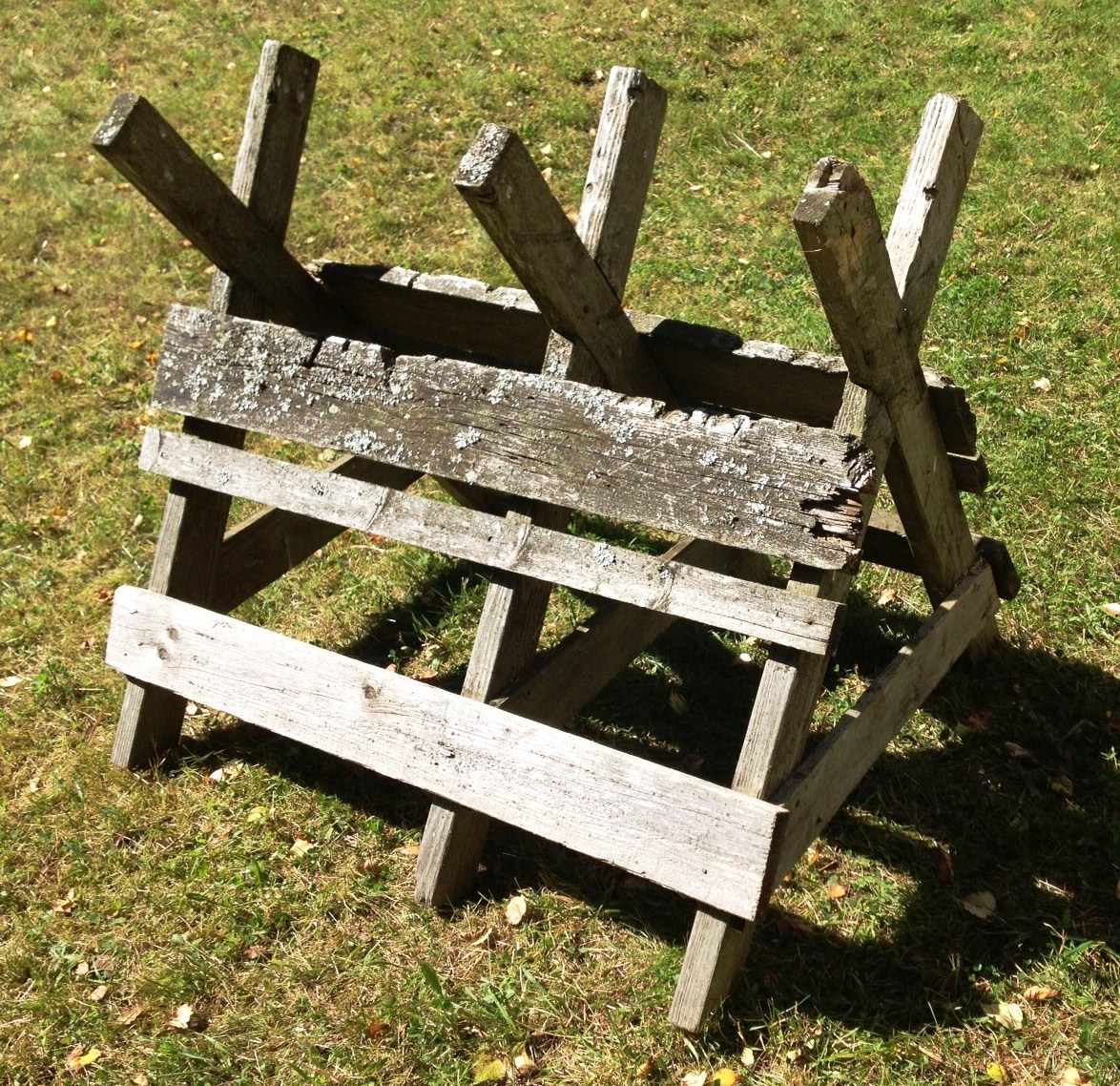|
Sawbuck
In woodworking, a sawbuck is a structure for holding wood so that it may be cut into pieces. Easily made in the field from rough material, it consists of an "X" form at each end which are joined by cross bars below the intersections of the X's. The wood to be cut is placed in the V's formed above the intersections of the X's. A sawbuck is very simple to build. The five "V" sawbuck was designed with 10 vertical 2×4s, and four horizontal, 2×6s, secured with wood screws. It was designed this way in order to cut two or more smaller pieces ( in length) of firewood in rapid succession. A sawbuck should be heavy enough to negate any kickback from the saw while cutting. Building a sawbuck that is too light could result in injury as it may tip over while cutting, especially with a chainsaw. In Canada and Britain, and the United States, a sawbuck is called a ''sawhorse'' or a sawstool, although this term also refers to a similar device used (often in pairs) to support wood planks. ... [...More Info...] [...Related Items...] OR: [Wikipedia] [Google] [Baidu] |
Sawbuck Table
A sawbuck table or X-frame table is a type of trestle table having X-shaped supports at either end. It takes its name from the similarity of these X-shaped supports to sawbucks. In addition to the supports, a sawbuck table is distinguished by a sturdy central rail and key- tenon joints holding the supports and central rail together. Historically, sawbuck tables also often featured footrests running the length of the table. The sawbuck table originated in Pennsylvania in the early 18th century, and is a characteristic example of Pennsylvania Dutch vernacular design. The design is sufficiently sturdy that some sawbuck tables have remained in regular use for over 200 years. The earliest known modern picnic table was derived from the sawbuck table design, with the addition of attached benches on either side. Picnic table builders continued to experiment with sawbuck designs having separate benches until the invention of the modern A-frame picnic table in 1926. Sawbuck-style picnic ta ... [...More Info...] [...Related Items...] OR: [Wikipedia] [Google] [Baidu] |
Sawhorse
In woodworking, a saw-horse or sawhorse (saw-buck, trestle, buck) is a trestle structure used to support a board or plank for sawing. A pair of sawhorses can support a plank, forming a scaffold. In certain circles, it is also known as a '' mule'' and a short sawhorse is known as a pony. The names come from the shape of the frame, which resembles a horse. A sawhorse may also be a rack for supporting logs for sawing, known in the US as a sawbuck. The sawhorse may be designed to fold for storage. A sawhorse with a wide top is particularly useful to support a board for sawing or as a field workbench, and is more useful as a single, but also more difficult to store. A sawhorse can also be used as the base for a portable work table by placing a sheet of plywood or even a door across two sawhorses. If the sawhorses are strong enough, the portable table can be used as a platform for tools like a table saw, although with caution if the top is not secured to the sawhorses. In boa ... [...More Info...] [...Related Items...] OR: [Wikipedia] [Google] [Baidu] |
Woodworking
Woodworking is the skill of making items from wood, and includes cabinet making (cabinetry and furniture), wood carving, joinery, carpentry, and woodturning. History Along with stone, clay and animal parts, wood was one of the first materials worked by early humans. Microwear analysis of the Mousterian stone tools used by the Neanderthals show that many were used to work wood. The development of civilization was closely tied to the development of increasingly greater degrees of skill in working these materials. Among early finds of wooden tools are the worked sticks from Kalambo Falls, Clacton-on-Sea and Lehringen. The spears from Schöningen (Germany) provide some of the first examples of wooden hunting gear. Flint tools were used for carving. Since Neolithic times, carved wooden vessels are known, for example, from the Linear Pottery culture wells at Kückhofen and Eythra. Examples of Bronze Age wood-carving include tree trunks worked into coffins from nor ... [...More Info...] [...Related Items...] OR: [Wikipedia] [Google] [Baidu] |
Wood
Wood is a porous and fibrous structural tissue found in the stems and roots of trees and other woody plants. It is an organic materiala natural composite of cellulose fibers that are strong in tension and embedded in a matrix of lignin that resists compression. Wood is sometimes defined as only the secondary xylem in the stems of trees, or it is defined more broadly to include the same type of tissue elsewhere such as in the roots of trees or shrubs. In a living tree it performs a support function, enabling woody plants to grow large or to stand up by themselves. It also conveys water and nutrients between the leaves, other growing tissues, and the roots. Wood may also refer to other plant materials with comparable properties, and to material engineered from wood, or woodchips or fiber. Wood has been used for thousands of years for fuel, as a construction material, for making tools and weapons, furniture and paper. More recently it emerged as a feedstock for the ... [...More Info...] [...Related Items...] OR: [Wikipedia] [Google] [Baidu] |
Lumber
Lumber is wood that has been processed into dimensional lumber, including beams and planks or boards, a stage in the process of wood production. Lumber is mainly used for construction framing, as well as finishing (floors, wall panels, window frames). Lumber has many uses beyond home building. Lumber is sometimes referred to as timber as an archaic term and still in England, while in most parts of the world (especially the United States and Canada) the term timber refers specifically to unprocessed wood fiber, such as cut logs or standing trees that have yet to be cut. Lumber may be supplied either rough- sawn, or surfaced on one or more of its faces. Beside pulpwood, ''rough lumber'' is the raw material for furniture-making, and manufacture of other items requiring cutting and shaping. It is available in many species, including hardwoods and softwoods, such as white pine and red pine, because of their low cost. ''Finished lumber'' is supplied in standard sizes, mostl ... [...More Info...] [...Related Items...] OR: [Wikipedia] [Google] [Baidu] |
United States Ten-dollar Bill
The United States ten-dollar bill ($10) is a denomination of U.S. currency. The obverse of the bill features the portrait of Alexander Hamilton, who served as the first U.S. Secretary of the Treasury. The reverse features the U.S. Treasury Building. All $10 bills issued today are Federal Reserve Notes. As of December 2018, the average life of a $10 bill in circulation is 5.3 years before it is replaced due to wear. Ten-dollar bills are delivered by Federal Reserve Banks in yellow straps. The source of the portrait on the $10 bill is John Trumbull's 1805 painting of Hamilton that belongs to the portrait collection of New York City Hall. The $10 bill is unique in that it is the only denomination in circulation in which the portrait faces to the left. It also features one of two non-presidents on currently issued U.S. bills, the other being Benjamin Franklin on the $100 bill. Hamilton is also the only person not born in the continental United States or British America (he was f ... [...More Info...] [...Related Items...] OR: [Wikipedia] [Google] [Baidu] |
Roman Numeral
Roman numerals are a numeral system that originated in ancient Rome and remained the usual way of writing numbers throughout Europe well into the Late Middle Ages. Numbers are written with combinations of letters from the Latin alphabet, each letter with a fixed integer value, modern style uses only these seven: The use of Roman numerals continued long after the decline of the Roman Empire. From the 14th century on, Roman numerals began to be replaced by Arabic numerals; however, this process was gradual, and the use of Roman numerals persists in some applications to this day. One place they are often seen is on clock faces. For instance, on the clock of Big Ben (designed in 1852), the hours from 1 to 12 are written as: The notations and can be read as "one less than five" (4) and "one less than ten" (9), although there is a tradition favouring representation of "4" as "" on Roman numeral clocks. Other common uses include year numbers on monuments and buildings an ... [...More Info...] [...Related Items...] OR: [Wikipedia] [Google] [Baidu] |
Woodworking
Woodworking is the skill of making items from wood, and includes cabinet making (cabinetry and furniture), wood carving, joinery, carpentry, and woodturning. History Along with stone, clay and animal parts, wood was one of the first materials worked by early humans. Microwear analysis of the Mousterian stone tools used by the Neanderthals show that many were used to work wood. The development of civilization was closely tied to the development of increasingly greater degrees of skill in working these materials. Among early finds of wooden tools are the worked sticks from Kalambo Falls, Clacton-on-Sea and Lehringen. The spears from Schöningen (Germany) provide some of the first examples of wooden hunting gear. Flint tools were used for carving. Since Neolithic times, carved wooden vessels are known, for example, from the Linear Pottery culture wells at Kückhofen and Eythra. Examples of Bronze Age wood-carving include tree trunks worked into coffins from nor ... [...More Info...] [...Related Items...] OR: [Wikipedia] [Google] [Baidu] |
Logging
Logging is the process of cutting, processing, and moving trees to a location for transport. It may include skidding, on-site processing, and loading of trees or logs onto trucks or skeleton cars. Logging is the beginning of a supply chain that provides raw material for many products societies worldwide use for housing, construction, energy, and consumer paper products. Logging systems are also used to manage forests, reduce the risk of wildfires, and restore ecosystem functions, though their efficiency for these purposes has been challenged. In forestry, the term logging is sometimes used narrowly to describe the logistics of moving wood from the stump to somewhere outside the forest, usually a sawmill or a lumber yard. In common usage, however, the term may cover a range of forestry or silviculture activities. Illegal logging refers to the harvesting, transportation, purchase, or sale of timber in violation of laws. The harvesting procedure itself may be illegal, i ... [...More Info...] [...Related Items...] OR: [Wikipedia] [Google] [Baidu] |
Bock (Gestell)
Bock is a strong beer in Germany, usually a dark lager. Several substyles exist, including: *Doppelbock (''Double Bock''), a stronger and maltier version *Eisbock (''Ice Bock''), a much stronger version made by partially freezing the beer and removing the ice that forms *Maibock (''May Bock''), a paler, more hopped version generally made for consumption at spring festivals. Due to its lighter color, it is also referred to as Heller Bock; from German ''hell'' (bright, light in color). *Weizenbock (''Wheat Bock''), a wheat beer made from 40–60% wheat History The style now known as ''Bock'' was first brewed in the 14th century in the Hanseatic town of Einbeck in Lower Saxony. The style was later adopted in Bavaria by Munich brewers in the 17th century. Due to their Bavarian accent, citizens of Munich pronounced "Einbeck" as "ein Bock" ("a billy goat"), and thus the beer became known as "Bock". A goat often appears on bottle labels. Bock is historically associated with spec ... [...More Info...] [...Related Items...] OR: [Wikipedia] [Google] [Baidu] |








